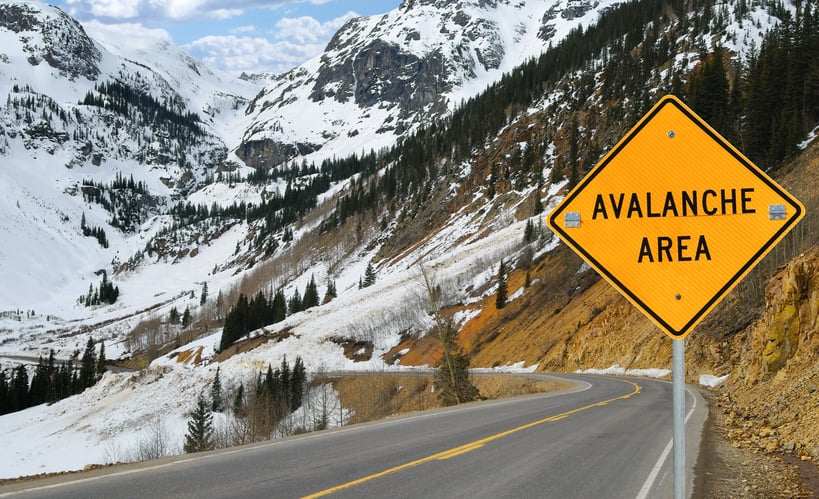Most locals and regular visitors know the depth of our current snowpack is different than it was this time last year and measurements of the Snow Water Equivalent (SWE) confirms this drastic difference. The USDA and Natural Resources Conservation Service (NRCS), based at the Federal Center in Lakewood, CO, tracks this information. As of December 31, 2023, the SWE in the Upper Colorado Headwaters, which includes Eagle County, is at 75% of the 20-year average. This time last year it measured at 127%. The last measurable snowfall was on December 24.

A sign warns motorists in an area of southwest Colorado where an avalanche has recently covered the road.
The state of the current snowpack highlights the inconsistent snowfalls we have received this winter season. Winter often comes early to the high elevations of Colorado, in late September or October, with periods of dry and cold weather. This dry and cold weather changes the shape of the snow grains from round to square or faceted shapes, which do not bond well together. These snow grains can easily be found by digging with your hand in an undisturbed area to the bottom of the snowpack and finding the faceted, or “sugar snow.” The longer the cold and dry weather persists, the more the current snowpack loses strength and creates weak layers whose bonds are likely to fail with the weight of additional snow. Dramatic examples of the current weak snowpack include a large avalanche on December 8 in East Vail that caught and carried a skier, who fortunately was not injured and was able to ski out on their own. This large avalanche occurred after a storm cycle that dropped up to 2 feet of snow at higher elevations in the Vail area. While the skiing and riding was excellent in-bounds at Vail where the snowpack is monitored and controlled by ski patrol, the additional weight of the new snow on top of the weak snow created dangerous avalanche conditions in the backcountry on steeper slopes.
Another dramatic example of the weak snowpack throughout Colorado, even in areas with more snow such as the Elk and Ragged mountains near Marble, occurred on November 25. A group of seven backcountry skiers triggered a large slide near Marble Peak and four of the party where caught. Again, fortunately no one was injured and they were able to extricate and evacuate themselves to the trailhead. This avalanche also occurred after two storms in the area added additional weight on the already weak snowpack. The second of these storms had high winds that created a wind slab, a stiff layer sitting on top of the weak layers. Wind slabs can be strong enough to bear the weight of a skier or snowboarder, however, they also have latent energy and if they fail a large avalanche can result, as occurred in this incident.
While we wait for more snow during this El Nino winter, we can make educated predictions about the current and future snowpack based on upcoming weather patterns. In the near term, while the avalanche danger continues to lessen, the strength of the snowpack continues to deteriorate and loose snow avalanches remain possible. In the short term, this means traveling on slopes below 30 degrees is highly advised. Most avalanches occur on slopes 30-45 degrees in steepness. Once it starts snowing again and additional weight is added onto the existing weak snowpack, we can expect an active avalanche cycle, especially with larger snowfall amounts and wind loading. In this case, travel in or near avalanche terrain will not be advised. The Colorado Avalanche Information Center, https://avalanche.state.co.us/, is the source for avalanche forecasting throughout the mountain regions of Colorado. The Center issues daily avalanche hazard and weather forecasts and their staff are in the field daily observing snow and avalanche terrain. Ski patrols and backcountry travelers throughout the state also share observations with CAIC, to provide a comprehensive overview of Colorado’s snowpack and avalanche hazard.
In the meantime, the winter backcountry remains a beautiful place to recreate and get away from it all. There are many locations without steep slopes for backcountry riding, cross country skiing and snowshoeing. Even though we are experiencing below average snowfall so far, there is still enough snow to experience the wonder of the Colorado winter.
Markian Feduschak is the President of Walking Mountains Science Center and a self-described snow
geek and passionate skier. Markian is also a board member of the Friends of the Colorado Avalanche
Information Center, a nonprofit organization that supports the Colorado Avalanche Information Center.







